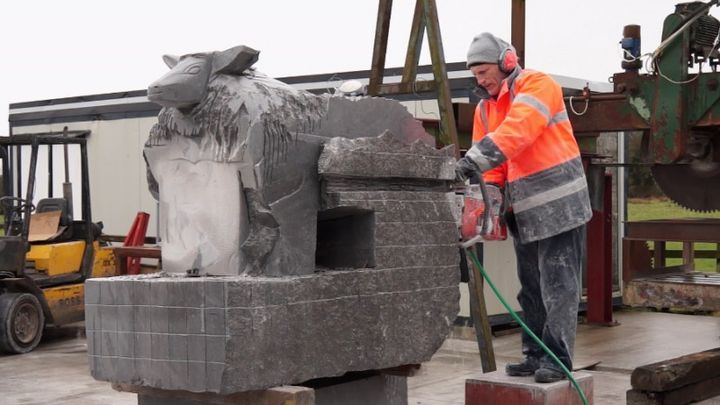
Roscommon Limestone Ewe and Lamb
Donation protected
A life-sized sculpture of a Roscommon ewe and lamb is being commissioned to celebrate the Roscommon Lamb festival the tenth anniversary. Local craftsman Mark Feeley is currently busy carving this sculpture out of a four-and-a-half-ton block of Lecarrow limestone. The block he is working on “rings” sweetly when struck with a sledgehammer which means it has no flaws or cracks and is thus perfect for carving. This sculpture will be erected in Roscommon town as a permanent reminder of the importance of the sheep industry to our county.
Limestone is the bedrock under much of the soil in Co Roscommon and is one of the factors which contribute to the high quality of our farm produce.
South Roscommon, in particular, is covered with dry stone [limestone] walls enclosing sheep pastures. In times past when wool was a valuable raw material, it was said that "dear wool and cheap labour built the big houses of Co Roscommon.
The Roscommon breed of sheep was exported all over the world in the late 1800s and early 1900s, to Argentina, Australia, England and was sought after for the quality of both its wool and its meat.
Sheep and goats were the second species to be domesticated by man. The dog was the first and the dog enabled the domestication of other species, [hence "mans' best friend"]. The tradition of sheep farming in Roscommon goes back into the mists of time and is continued to this day. The Lamb Festival celebrates this tradition and uses it to highlight other positive aspects of life in our county.
Our county crest features a sheep's head along with the oak leaf and the crown, reflecting the importance of sheep farming to the county.
The photo shows Mark Feely using a stone chainsaw, the chains for which cost 500.00 each. The final sculpture will feature a lamb at the front of the ewe. We expect to unveil the sculpture at the special sheep sale at Roscommon Mart which opens the festival on 26th April this year. We are planning to erect the sculpture in the square in Roscommon for permanent display.
We are aiming to raise €5000. Any donation is greatly appreciated. Thank you.
Help spread the word!
View This Years Festival
Limestone is the bedrock under much of the soil in Co Roscommon and is one of the factors which contribute to the high quality of our farm produce.
South Roscommon, in particular, is covered with dry stone [limestone] walls enclosing sheep pastures. In times past when wool was a valuable raw material, it was said that "dear wool and cheap labour built the big houses of Co Roscommon.
The Roscommon breed of sheep was exported all over the world in the late 1800s and early 1900s, to Argentina, Australia, England and was sought after for the quality of both its wool and its meat.
Sheep and goats were the second species to be domesticated by man. The dog was the first and the dog enabled the domestication of other species, [hence "mans' best friend"]. The tradition of sheep farming in Roscommon goes back into the mists of time and is continued to this day. The Lamb Festival celebrates this tradition and uses it to highlight other positive aspects of life in our county.
Our county crest features a sheep's head along with the oak leaf and the crown, reflecting the importance of sheep farming to the county.
The photo shows Mark Feely using a stone chainsaw, the chains for which cost 500.00 each. The final sculpture will feature a lamb at the front of the ewe. We expect to unveil the sculpture at the special sheep sale at Roscommon Mart which opens the festival on 26th April this year. We are planning to erect the sculpture in the square in Roscommon for permanent display.
We are aiming to raise €5000. Any donation is greatly appreciated. Thank you.
Help spread the word!
View This Years Festival
Organizer
Will Keane
Organizer
County Roscommon, Roscommon